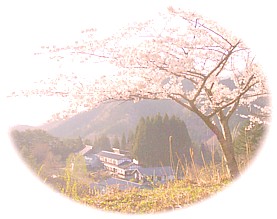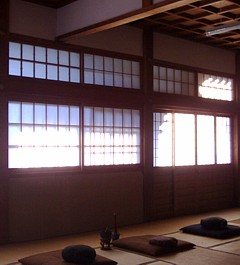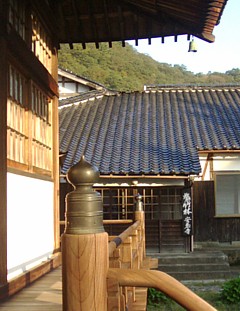|
|---|
 How to sit 4 "a map for letting go all maps" (Adult Practice XXIV) |
In the English booklet "Sôtô Zen", Okumura Shôhaku Rôshi points out that zazen means to let go off all maps. He says: "Zazen is not correcting the distorted map." So if instructions for zazen can be called a kind of map, what we are looking for here is a "map for letting go all maps" - which is paradoxical. And we found that all maps of zazen are distorted somehow. What shall we do? Just let go off the map and return to the real thing? But our problem seems to be that we have no idea what that real thing is. Actually, when we realize this having "no idea", we are as close to the real thing as we could possibly be. When, on the other hand, we get an idea of that "real thing", it turns out to be just another point on our distorted map. And that is when looking at a different map becomes useful, because we will realize our own mistake. We just have to keep in mind that no map ever is the real thing - it just tries to be a map of the real thing. Any map is necessarily distorted, and when we look at a map, we have to find out exactly how distorted it is, otherwise the map won't bring us closer to anything. So what we are doing here is investigating a map - we are not investigating zazen itself, and we are certainly not practicing zazen here on the Internet. It is like we were drawing a map of a map - which gets us further and further away from the real thing. Therefore, if you have the opportunity to just sit with fellow practioners, I would advise you to do so rather than read my following comments about just another "map for letting go maps". Only for those who just can't sit still on their cushions, I will start with investigating Sawaki Kôdô Rôshi's "Instructions on how to sit correctly in zazen":
In "Sôtô Zen", Okumura Rôshi makes an important comment: Apart from the points mentioned above, Sawaki Rôshi also adds that there should be no wind, smoke or smells at the place where you sit. About twelve years ago I was still living in Kyôto as a graduate student, in an area close to the university, but also not too far from the mountains. It wasn't a really noisy environment, but during the daytime there were of course always voices that could be heard from the street or the sound of cars. So I was always looking forward to the quietude of the sesshins at Antaiji which I would attend once or twice each month. Antaiji is at the end of a dead end road in the mountains, the next village is five kilometers down the stream. So the only traffic that can be heard is the mail man who comes on week days (except during the winter time) and a plane now and then. There is only one exception: The Japanese government is using large sums of money to protect the mountains against erosion, and the area around Antaiji is one of those designated for dehydrating the hill sides and building dams to prevent earth slides. That means that whenever one of these projects is going on, trucks and other heavy machinery will move in the temple precincts, and they can be pretty noisy indeed at times. Of course, the work doesn't stop just because it is sesshin at Antaiji. So it would happen that I would make all the way from Kyôto by train and bus and foot up to Antaiji to enjoy the silence during sesshin - and what do I find? It is even noisier than where I lived in the city! I could get furious during zazen at the trucks that get coming and going and interrupted my "concentration", but also at the Japanese monks who seemed to be not concerned at all, some of them happily sleeping through all the noise. Why couldn't someone tell these people to stop the construction at least during the sesshin!? They can continue with that noise when I'm back in Kyôto, I thought. What did I finally learn from this experience? The simple fact that the "noise" is not so much around us - we create it in our own mind. Practicing patience does not mean to grind one's teeth and suppress the thought: "Why can't all you people just shut up!" It rather means to be quite oneself, and accept what has to be accepted. A couple of years later, after I became a monk at Antaiji, I was taught another lesson in patience. To commemorate the 20th anniversary of Antaiji's move from Kyôto to its present location, the former abbot, Miyaura Rôshi, had the idea to build a new zendo. Until then, we had been sitting in the main hall, which also functioned as zendo. For almost a whole year, all of the sesshins (which are held twice each month) were transformed into "samu sesshins", that means that there was no zazen at all, but people would get up at five and work until seven or eight in the evening, non-stop, except for three meals daily. Thus, the hall was build without the help of professional construction workers, only by the Antaiji monks with almost no budget at all. There were several reasons that led to the decision: The main hall is big enough to accomodate 20 to 30 people, but that is more than usually needed (we have seldom been more than 12 or 13 people during the last 18 years), and it is also too much space to heat during the winter. Heating in winter is also a problem because of the many cracks in the wall that is slowly coming down: Even though the wood stove in the center of the hall would keep everyone's backs hot, on a stormy day the wind - sometimes even mixed with snow - would blow right into your face and around your shoulders. It could happen that sweat would be running down your back while your fingers got stiff from the freezing cold. In summer though, it was hot. Even though at Antaiji, located in the mountains close to the Japanese Sea, the temperatures do not rise as high as in other parts of Japan, it would still be uncomfortably hot in the main hall, especially during the day time zazen periods of sesshins. Some people thought that a zendo with more windows would help ventilation. The new zendo was to have windows not only above people's heads, but also at the lower bottom of the walls, so that they could be opened during the summer to let in a fresh breeze that would cool down people's sweating legs and hands. The main hall has - just like most Buddhist halls and also old Japanese farming houses - a large roof that covers not only the building itself, but also extends further down to protect the wooden gallery that leads around the hall. Therefore, except for the months of November, December and January, the sun usually doesn't shine directly into the windows, which are protected by paper screen from the inside. That leads to a kind of dim light inside the hall even during the day time. This is ideal for zazen, but it somehow led the monks to the idea that the dim light in the hall was responsible for their constantly falling asleep during zazen. If the sun could fall directly through the windows, it was said, that would help us stay concentrated and awake. For the same reason it was decided that the new zendo should have fluorescent light instead of the normal bulbs that light up the main hall - unlike many Europeans, the Japanese prefer fluorescent lamps to ordinary lamps, not only because they are considered economical, but also because they are brighter. The light of an ordinary bulb that a Westerner might characterize as a "warm" light is disliked by many Japanese as "too dark". Another factor to be considered were noises: Although hardly any noises can be heard around Antaiji except for those made by birds and insects, wind and rain, sounds from inside the building would sometimes disturb the atmosphere inside the main hall. The hall was not too far away from the kitchen, and when the cook was absent minded in his work, the sounds of pots being put on the stove or plates being washed would be well audible during zazen. So the new zendo was constructed in the back of the building, on the opposite side of the kitchen. The new location had the disadvantage of being right next to the toilets though, and people that went to relief themselves during kinhin often forgot that all the noise they made could be heard by those who stayed back in the zendo to practice walking meditation, while those in the zendo were often quite sharp when it came to making out who was making what noises in the toilet. After sesshin, people would enjoy conversations like: "Did you notice that the cook never washes his hands after he's finished with his business? And he's heading towards preparing our meals right after that!" Once we were sitting in the new "ideal" zendo, we found that we had to practice even more patience than before, in the main hall. But let me continue next month.
(Docho)
|
|---|
 
The inside and outside of the main hall on a late autumn afternoon. |
  Ten years since the "Aum sarin attack" How the Rinzai and Ôbaku sects defined the problem (Part II) |
How did Japanese Zen deal with the Sarin attack that was performed by the Aum cult in the Tokyo subway ten years ago? First I want to start to investigate how the Rinzai and Ôbaku sects related to the problem. Today there are three different Zen sects in Japan, the Sôtô, Rinzai and Ôbaku sects. Among these, the Ôbaku sect, which was transmitted to Japan by the Chinese priest Ingen in 1654, is the youngest and smallest. In fact, Ingen is also credited for bringing beans for the first time from China to Japan, and today every Japanese knows "Ingen" as the name of that bean, while almost no-one knows anything about the Zen priest Ingen or the school of Zen he transmitted to Japan. The Rinzai school however, which traces itself back to the same tradition as the Ôbaku sect (Ôbaku is the name of Rinzai's teacher), was transmitted earlier to Japan and was more succesful in establishing itself as one of the many Buddhist sects that influenced Japan culturally and spiritually. When Zen was introduced to the West first through the writings of D.T. Suzuki, this Zen was actually Rinzai Zen with its emphasis on Kôans and Satori. Unlike Sôtô Zen, which is sometimes referred to degetorially as "peasant Zen", Rinzai Zen is also prominent for having expressed itself uniquely in many of the traditional Japanese arts, like the art of tea, archery, garden architecture and flower arrangement. On the other hand, many of these arts on close inspection turn out to be nothing more than a way for the bored aristocratical circles in the old capital of Kyôto to kill their time. Few Westerners seem to know that in the old days, becoming a Rinzai Zen monk was a popular way for aristocrats and Samurais to retire from their secular responsibilties and enjoy a life of leisure. So called "Zen culture" is only one by-product of this social trend and has not much to do with the teaching of Shakyamuni Buddha. Be that as it may, after the Sarin incident occured ten years ago, the Rinzai and Ôbaku responsibilties gathered for a series of meetings to discuss the impact of the attack and how to react to it. These meetings took place during the course of ten months, and the results can be found (in Japanese) on the web-site of the Institute for Zen Studies (http://www.zenbunka.or.jp/03_magazine/index5_2.htm). The Rinzai and Ôbaku officials defined the problem not just as one of a pseudo-Buddhist cult that went amok, but rather as one of the Buddhist establishment itself, that means as a problem for each individual Zen priest. Let me quote from their papers: "'WHAT do WE have to do now?' - this 'WHAT?' refers certainly not just to analysing and criticing the doctrine and practice of the Aum cult by pointing out its pseudo-religious nature, as it is done by many social critics recently. Doing this, we would do nothing more but merely justify our own point of view. Of course it is important to point out how our point of view differs from that of the Aum cult. But if that is all we do, that won't help to throw any light on the real problem, and - what is even worse - by justifying our own point of view, we will only hide the factors of the real problem which also lie in the present state of our Buddhist establishment. By pretending that the problem is only a problem of the Aum cult, we will fool ourselves into believing that there is no problem on our own side. So what is asked of ourselves now is to first have a good look at ourselves: Is that what we claim to be our own point of view, really the truth? And does that what we practice in our day to day lives have anything to do with that what we officially claim to be our point of view? When we ask ourselves then 'WHAT to do?', this 'WHAT?' must not be a self-justification, but rather a questioning of our own responsibility. Our responsibility is to give an answer to those young men and women who entered the Aum cult in search for liberation, and also to all those other people in the modern world that wander around in illusion, looking for their true selves. We have to reflect honestly on the fact that for too long we have been neglecting this responsibilty, that we haven't been able to embrace and accept the lost souls of those young seekers. The answer to the questions at hand - 'WHAT do WE have to do now?' 'WHAT are WE able to do now?' - can only come out of a deep reflection on ourselves." This statement is a little philosphical perhaps, but the point that the problem posed by the Sarin attacks is not one of the Aum cult alone, but of each single one of us, strikes me as incredibly honest. This is exactly what in Zen is called "kyakka shôkô" - throwing light on one's own feet - or "ekô henshô" - turning the light inwards and reflect on oneself. Next month let us investigate how this problem was developed further inside the Rinzai and Ôbaku sects.
to be continued ... (Muho)
|
|---|
